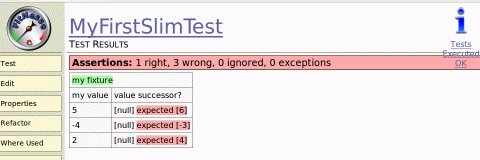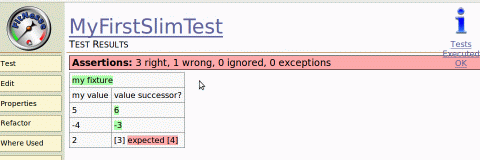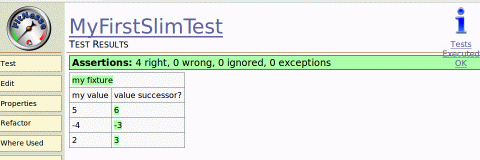Write a first test with FitNesse and PhpSlim
The first wiki page
After having started the FitNesse server in the Installation, create your first wiki page by browsing to a non-existing page http://localhost:8070/MyFirstSlimTest.
Overwrite the !contents -R2 -g -p -f -h with
!|my fixture |
|my value|value successor?|
|5 |6 |
|-4 |-3 |
|2 |4 |and click on Save. We just created our first specification (or test) with a Decision Table. Since the page name MyFirstSlimTest ends with Test, FitNesse automatically provides the Test button. Click on it now.
You will see a lot of yellow bars showing exception messages. The Slim executor tried to call into PHP code which does not exist yet.
You see the message my fixture Could not invoke constructor for MyFixture. The header of the table is translated into a camel case class name. PhpSlim does this translation and is oriented at the Zend naming conventions. A future revision of PhpSlim might allow configurable translation rules, especially serving for upcoming PHP name spaces.
Let’s write some code
First create a Slim sub directory in your project directory.
Do you remember the
/path/to/project/Slim, resp.${FITNESSE_ROOTPATH}/Sliminclude path setting in therootpage?
Then create a file MyFixture.php for the PHP class in that Slim directory and fill it with
<?php
class MyFixture
{
}
I did intentionally leave out the closing
?>tag.
Click Test again. Now the table header my fixture is green and on top of the page you see Assertions: 1 right, 0 wrong, 0 ignored, 12 exceptions. We got 1 right already!
Let’s move on. You see the exception messages
Method setMyValue[1] not found in MyFixture.
Method valueSuccessor[0] not found in MyFixture.On a Decision Table the Slim executor instantiates an object of the class specified in the table header and then attempts to call into the object. A column header (i.e. in the second row of the table) specifies the method name to call. A set prefix is added, if the column header does not end with a ”?”. For each row in the table, the calls are made from left to right and the return value of a ”?” method is compared with the value in the cell.
The setMyValue[1] tells you, that the executor attempts to call a setMyValue method with one argument. The getter method valueSuccessor should not take an argument.
Let’s implement them.
<?php
class MyFixture
{
public function setMyValue($value)
{
}
public function valueSuccessor()
{
}
}
Run the Test. Great, no more exceptions, just 3 wrong. You can see [null] expected [6] in red.
Obviously the valueSuccessor method does not return anything, in PHP this is equivalent to explictely returning null. So we finish the fixture class.
<?php
class MyFixture
{
private $_myValue;
public function setMyValue($value)
{
$this->_myValue = (int) $value;
}
public function valueSuccessor()
{
return $this->_myValue + 1;
}
}
Ah - only one more error [3] expected [4]. And this error is actually an error in the specification. The successor of 2 is 3. So click on the edit button and correct this mistake.
!|my fixture |
|my value|value successor?|
|5 |6 |
|-4 |-3 |
|2 |3 |Click Save and then Test.
You made it. We have a green bar on top, stating Assertions: 4 right, 0 wrong, 0 ignored, 0 exceptions.
Take a break now. You can stop the FitNesse server by opening the page http://localhost:8070/?responder=shutdown.
There will be more tutorials soon.




